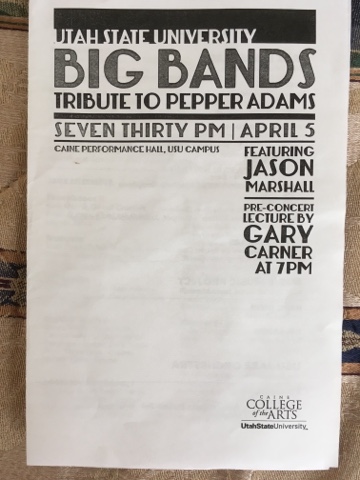{SEE BELOW}
This month has been an exciting one. Much to my surprise, I found thirteen
unmarked tapes that I had to review. Some fascinating material came out
of them, especially regarding Pepper and Elvin Jones’ early days together
in New York City. I even found a tape of Tommy Flanagan’s trio live at the
Village Vanguard!
Most of my efforts continue to be readying the first part of the biography for
publication. I’m in the process of making my final edits, then passing it on
to three readers for their final comments. That will push the publication date
into January but make for a stronger book.
I’ve put some time, too, into writing Chapter 7. It covers Adams’ recordings
from 1963-1977. I expect a first draft to be in place by the end of the year.
That’s well ahead of schedule. For my work on this chapter, I’ve been
listening to all my versions of Pepper’s Thad/Mel solos features. Although
there are sixteen of them, six in particular form the core of Pepper’s solos
with the band: “Once Around,” “Three and One,” “Us,” “Thank You,” “Little
Rascal on a Rock” and “My Centennial.”
Tony Faulkner sent me an exciting video of the University of Illinois Concert
Jazz Band. Three Pepper tunes are played: “Patrice” (at 9:00), “Mary's Blues”
(at 1:14:40) and “Etude Diabolique” (at 1:32:45). “Patrice” features Glenn
Wilson bs. “Mary's Blues” features Ron Bridgewater ts and Carlos Vega
ts. “Etude Diabolique” features all three plus Chip McNeill ts.
Two Pepper concerts, both jam sessions done at the Highlights of Jazz series
In New York, are available to check out. The first was led by David Amram
towards the bottom of the page. On -a, Adams solos begin at 9:55, 35:52;
48:24., and 1:05:12. A “Tribute to Al Cohn” took place on December 15, 1977.
Pepper’s solo on “In a Mellow Tone” begins at 44:32. His ballad feature on
I’ll let you find them.
I’ve gotten commitments from three European writers to review the biography.
Because everyone prefers a hard copy edition but the Pepper book will be
released only as an ebook, it was necessary to explain to them my rationale
for that decision. The following will be posted soon at pepperadams.com:
A Word About Hard Copy
Books vs. Ebooks
The only publishers who produce hard copy books about important yet unglamorous
jazz figures are either academic or small independent presses. To keep the cover price
affordable, their modus operandi is to include mostly text and not exceed around 250
pages. Music examples and musicological analysis, in particular, are anathema. It
increases the book’s cost and scares off a substantial part of their readership.
We strongly feel, however, that Pepper Adams is worthy of a major study well beyond
what these publishers will accept. For one thing, a 250 page limit for this work’s
biographical and cultural study (Part One) would necessitate significant excisions,
even, as was suggested, if the entire first part was decoupled from the musicological
section (Part Two) and published as a freestanding volume. Secondly, the musical
analysis of Adams’ artistry is the science that proves his many accomplishments. Best
conjoined with the biographical study, it buttresses some of the assessments in Part One
just as surely as the biography contextualizes the analysis of Part Two. Simply put, they
need each other.
Although the authors are fully aware that many readers prefer hard copy books, the way
that the current publishing landscape restricts jazz scholarship is the reason why an ebook
for a work of this kind is the only sensible alternative. By cutting out the middleman, we
don’t have to reconsider the book’s length or scope. Photographs, music examples,
and audio samples, too, aren’t a constraint.
We’re especially excited that our interactive, multidimensional study allows the reader to
listen to the recordings that are discussed in the book, and view an array of photographs
and other related material. To that aim, all the links that are enabled within the text are tied
to corresponding documentation that’s found at other websites. Furthermore, we’ve
Designed an inclusionary approach to Part Two so that musicians and non-musicians alike
can appreciate Adams’ eminence. Divided into two sections, the first part will contain
general observations about his style that can be understood by non-musicians. The other,
quite technical and intended for musicians, will include musical jargon and notation.
Three separate ebook installments will be released upon completion. “The Life of Pepper
Adams” (Part One, 1930-1955) will be published first: Chapters 1-3 in 2020, Chapters
4-10 a year later. “The Music of Pepper Adams” (Part Two, 1956-1986) will be published
by 2029, in time for Adams’ centennial in 2030. Please join us for the worldwide
celebration.
















